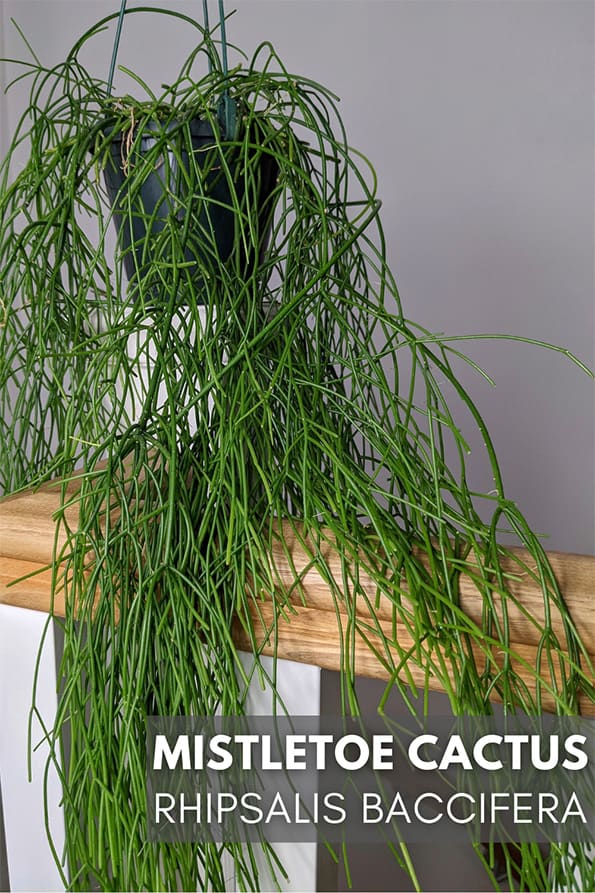As pet owners, we often find ourselves balancing the joy of nurturing plants with the safety of our furry companions. One of the easiest ways to ensure pet safety is by selecting non-toxic plants for our homes. Fortunately, the ASPCA provides a comprehensive list of plants that are safe for dogs, cats, and other pets. Among these, the Mistletoe Cactus (Rhipsalis Baccifera) stands out as a particularly pet-friendly choice.
Article-at-a-Glance
- The ASPCA list includes a variety of non-toxic plants that are safe for pets, including the Mistletoe Cactus.
- Mistletoe Cactus is a unique plant that thrives in low to medium light and requires moderate watering.
- This plant is completely safe for dogs and cats, posing no risk of poisoning if ingested.
- In addition to being pet-safe, the Mistletoe Cactus also contributes to cleaner indoor air.
- Understanding how to care for this plant ensures it remains a beautiful and safe addition to your home.
Ensuring Pet Safety with Non-Toxic Plants
Bringing plants into your home can enhance the environment in numerous ways. They add a touch of nature, improve air quality, and can even boost your mood. However, if you have pets, it’s crucial to ensure that the plants you choose are safe for them. Non-toxic plants are those that won’t harm your pets if they decide to take a nibble. This is particularly important because many common houseplants can be toxic to animals, leading to symptoms ranging from mild stomach upset to severe poisoning.
The ASPCA’s list of non-toxic plants is an excellent resource for pet owners. It includes a wide range of options, from flowering plants to succulents and ferns. By choosing from this list, you can enjoy the beauty of plants without worrying about your pets’ safety.
The Importance of Non-Toxic Plants for Pets
Choosing non-toxic plants is more than just a precaution; it’s a responsibility. Pets are naturally curious creatures. Dogs might chew on leaves, while cats are notorious for batting at dangling vines or climbing onto shelves to investigate greenery. When pets interact with plants, there’s always a risk of ingestion. By opting for non-toxic varieties, you eliminate the risk of poisoning and ensure your home remains a safe space for all its inhabitants.
Moreover, non-toxic plants can offer additional benefits. They can serve as natural air purifiers, helping to remove toxins and improve indoor air quality. This is particularly beneficial for pets, who spend a significant amount of time indoors. For more information on how pets can positively impact health, check out how pets can help slow down cognitive decline.
Choosing Dog and Cat Safe Plants
When selecting plants, it’s important to consider both aesthetics and safety. The Mistletoe Cactus, for instance, is not only visually appealing but also completely safe for pets. Here are some tips for choosing the right plants:
- Refer to the ASPCA’s list of non-toxic plants to ensure the species you select are safe.
- Consider your home’s lighting and space availability to choose plants that will thrive.
- Research each plant’s care requirements to ensure you can provide the proper environment.
Benefits of Non-Toxic Plants in the Home
Besides ensuring pet safety, non-toxic plants can enhance your home in many ways. They can reduce stress, increase humidity, and even help filter pollutants from the air. This creates a healthier living environment for both you and your pets. Additionally, plants can add a decorative touch to any room, bringing color and life to your space.
Non-toxic plants like the Mistletoe Cactus are particularly beneficial because they require minimal care while offering these advantages. Their unique appearance can serve as a focal point in your home, all while being a safe choice for your pets.
“Mistletoe Cactus (Rhipsalis baccifera …” from www.ourhouseplants.com and used with no modifications.
Mistletoe Cactus: A Pet-Friendly Choice
The Mistletoe Cactus is an ideal plant for pet owners. Not only is it non-toxic, but it also has a distinctive appearance that can add character to your home. This cactus is unlike the typical desert variety; it’s an epiphytic plant, meaning it naturally grows on other plants rather than in soil. This unique characteristic makes it a fascinating addition to any plant collection.
Why Mistletoe Cactus is Safe for Pets
The Mistletoe Cactus is safe for all pets, including dogs and cats. Unlike some plants that can cause severe reactions if ingested, this cactus poses no such risk. Its non-toxic nature means you can place it anywhere in your home without worrying about your pets’ curiosity leading to an emergency vet visit.
Besides being non-toxic, the Mistletoe Cactus is also free from spines, which makes it a safer option for homes with pets that like to explore with their paws or mouths.
- No toxic compounds are present in the plant.
- Safe for both cats and dogs, regardless of size or breed.
- No harmful effects if chewed or ingested.
Rhipsalis Baccifera: Key Features
Rhipsalis Baccifera, commonly known as the Mistletoe Cactus, is characterized by its long, slender, segmented stems. These stems can grow quite long and often cascade beautifully over the edges of pots or hanging baskets. This growth habit makes it an attractive choice for hanging displays or as a centerpiece on a shelf.
The plant is native to tropical and subtropical regions, thriving in environments with filtered light and high humidity. It’s a resilient plant that can adapt to various indoor conditions, making it an excellent choice for both novice and experienced plant enthusiasts. For those interested in learning more about how to introduce pets to new environments, you can read about pet socialization.
Cultivating a Safe Environment at Home
Creating a safe environment for your pets involves more than just choosing the right plants. It’s about understanding how to integrate these plants into your home in a way that enhances both safety and aesthetics. Consider placing pet-safe plants like the Mistletoe Cactus in areas where your pets spend the most time. This not only ensures their safety but also allows them to enjoy the benefits these plants provide.
Additionally, be mindful of plant placement. Hanging baskets or elevated shelves can keep plants out of reach while still allowing you to enjoy their beauty. Regularly check for any signs of damage to the plants, which could indicate your pets are interacting with them more than you’d like.
Caring for Mistletoe Cactus
Caring for a Mistletoe Cactus is relatively straightforward, making it a great choice for those new to plant care. This resilient plant thrives in conditions that mimic its natural habitat, which are typically found in tropical and subtropical regions. By providing the right environment, you can ensure your Mistletoe Cactus remains healthy and vibrant. If you’re interested in learning more about how to introduce your plant to new environments, check out our guide on pet socialization.
Optimal Watering Techniques
When it comes to watering your Mistletoe Cactus, moderation is key. Unlike desert cacti, which thrive on infrequent watering, the Mistletoe Cactus prefers a more consistent schedule. However, it’s important to avoid overwatering, as this can lead to root rot.
Here’s a simple guide to watering: If you’re unable to care for your plants or pets, there are solutions available for seniors that can help ensure they receive the attention they need.
- Allow the top inch of soil to dry out before watering again.
- Water thoroughly, allowing excess water to drain out of the pot.
- During the growing season (spring and summer), water more frequently.
- Reduce watering in the winter months when the plant’s growth slows down.
Finding the Perfect Lighting
The Mistletoe Cactus thrives in bright, indirect light. Direct sunlight can scorch its delicate stems, so it’s best to avoid placing it in south-facing windows. Instead, opt for east or north-facing windows where the light is less intense. For more tips on creating a pet-friendly environment, check out this guide on pet socialization and introducing pets to new environments.
If natural light is limited, consider using grow lights to supplement the lighting needs of your Mistletoe Cactus. This ensures it receives the adequate light required for healthy growth and development.
Soil and Fertilization Requirements
The Mistletoe Cactus prefers a well-draining soil mix, similar to what you would use for other epiphytic plants. A combination of peat, perlite, and orchid bark can provide the ideal environment for root growth.
Fertilizing is another important aspect of care. During the growing season, feed your Mistletoe Cactus with a balanced, water-soluble fertilizer every month. Be sure to dilute the fertilizer to half the recommended strength to avoid over-fertilization, which can damage the plant.
Temperature and Humidity Preferences
This plant enjoys warm temperatures, ideally between 60-80°F (15-27°C). It’s important to keep it away from drafts or sudden temperature changes, which can stress the plant. For those who may struggle with maintaining plant care, there are solutions for seniors unable to care for pets that can also apply to plant care.
Humidity is another factor to consider. The Mistletoe Cactus prefers a humid environment, similar to its native tropical habitat. If your home is particularly dry, especially during winter, consider using a humidifier or placing the plant on a pebble tray filled with water to increase humidity around it.
Enhancing Indoor Air Quality
One of the lesser-known benefits of houseplants is their ability to improve indoor air quality. Plants absorb carbon dioxide and release oxygen, creating a healthier environment for you and your pets. The Mistletoe Cactus, while not the most efficient air purifier, still contributes to a cleaner indoor atmosphere.
Role of Plants in Air Purification
Plants play a crucial role in removing toxins from the air. Common indoor pollutants such as formaldehyde, benzene, and trichloroethylene can be absorbed by plants, making them natural air purifiers. This is particularly beneficial in homes where air circulation may be limited.
Additionally, plants can increase humidity levels, which can help alleviate dry skin and respiratory issues, especially during the winter months when indoor heating is used.
Mistletoe Cactus’ Contribution to Clean Air
While the Mistletoe Cactus may not top the list of air-purifying plants, it still contributes to the overall air quality in your home. Its unique structure allows it to participate in the natural process of photosynthesis, converting carbon dioxide into oxygen and filtering out some pollutants in the process.
When combined with other air-purifying plants, the Mistletoe Cactus can enhance the air-cleaning capacity of your indoor garden. Consider grouping it with plants like the Peace Lily or Spider Plant for maximum benefits.
Combining Plants for Maximum Benefit
Integrating various non-toxic plants in your home can amplify the benefits they provide. Each plant has unique characteristics that contribute to a healthier living space, and by combining them, you can maximize these advantages. The Mistletoe Cactus, with its distinctive cascading stems, pairs beautifully with other plants both aesthetically and functionally.
Consider creating a mini indoor garden with a mix of plants that vary in height, texture, and color. This not only enhances the visual appeal but also optimizes the air purification capabilities. Grouping plants together increases humidity levels and can create a microenvironment that is ideal for plant growth.
Understanding Plant Rarity and Its Benefits
Owning rare plants like the Mistletoe Cactus can be a rewarding experience. These plants often have unique growth habits and appearances that set them apart from more common varieties. Additionally, rare plants can become a talking point among guests and fellow plant enthusiasts.
Overview of Rhipsalis Baccifera’s Rarity
Rhipsalis Baccifera is not your typical houseplant. As the only cactus naturally found outside the Americas, it holds a special place in plant collections. Its rarity adds to its charm, making it a prized possession for those who appreciate unique flora.
Why Rare Plants Matter in Home Décor
Incorporating rare plants into your home décor can elevate the overall aesthetic. These plants often have striking features that can serve as focal points in a room. The Mistletoe Cactus, with its cascading stems, can be displayed in hanging planters or on high shelves to draw the eye upward and create a sense of depth in your space.
Incorporating Rare Plants into Your Collection
When adding rare plants like the Mistletoe Cactus to your collection, it’s important to consider their specific care requirements. Research each plant’s needs and ensure you can provide the right environment for them to thrive. By doing so, you’ll not only enhance your home but also ensure the longevity and health of your plants.
Additionally, consider the placement of these plants. Rare plants deserve a spot where they can be admired and appreciated. Think about how they interact with the lighting and other elements in your home to create a harmonious balance.
Frequently Asked Questions
As a pet owner, you may have questions about the safety and care of the Mistletoe Cactus. Here are some common inquiries to help guide you:
Is Mistletoe Cactus safe for all pets?
Yes, the Mistletoe Cactus is completely non-toxic to both cats and dogs. It poses no risk if ingested, making it a safe choice for households with pets.
How often should I water my Mistletoe Cactus?
Water your Mistletoe Cactus when the top inch of soil feels dry. This usually means watering every 1-2 weeks, depending on your home’s humidity and temperature.
By selecting non-toxic plants and understanding their care requirements, you can create a home that is both beautiful and safe for your pets. The Mistletoe Cactus, with its unique appearance and pet-friendly nature, is an excellent addition to any household.
Remember to regularly check on your plants and adjust care routines as needed. With the right attention, your Mistletoe Cactus will thrive, contributing to a healthier and more vibrant living space for you and your furry friends.
Incorporating a variety of non-toxic plants into your home not only enhances its aesthetic appeal but also ensures a safe environment for your pets. With the information and tips provided, you’re well-equipped to create a beautiful, pet-friendly home.
The ASPCA provides a list of non-toxic plants to ensure the safety of pets like dogs and cats. One such plant is the Mistletoe Cactus (Rhipsalis Baccifera), which is safe for pets. It’s important to know how to care for these plants, as they thrive in full sun and help clean the air. Due to their rarity, they can be a unique addition to your home. For more detailed care instructions, visit this guide on growing and caring for Mistletoe Cactus.






